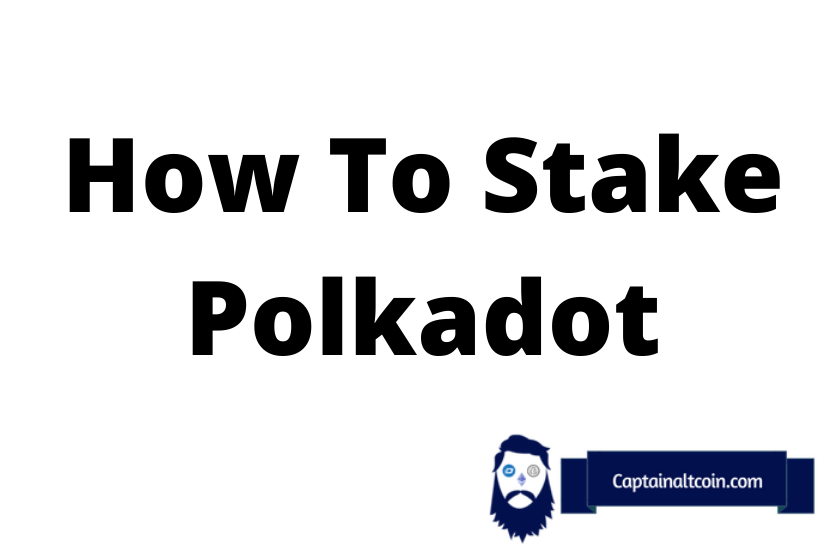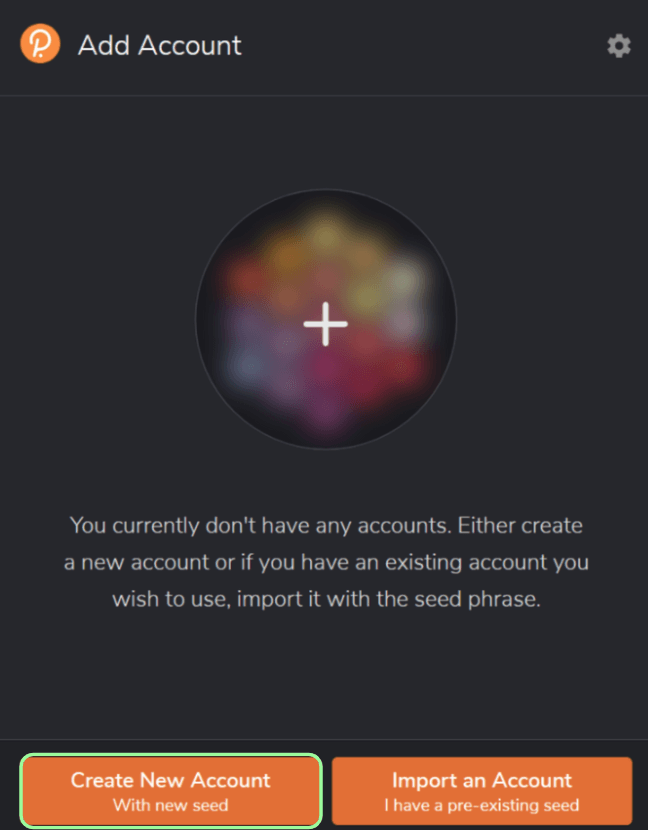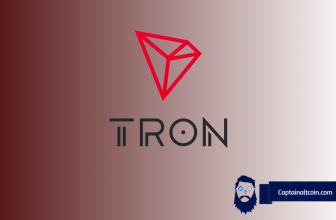
Anyone who’s been in the crypto market long enough has heard about Polkadot. A new Ethereum competitors with superior technology that aims to connect Blockchains and ease the data exchanging. What is probably less known is that you can participate in securing and verifying transactions in the Polkadot Relay Chain, and be rewarded for it. The process is called staking, and today we will take a closer look at how it all works. So let’s get into it.

What you'll learn 👉
Step 1: Create a Polkadot Stash Account
First things first, create a Polkadot account. Polkadot recommends that you create two accounts, a stash, and a controller account. So let’s start with the Stash Account.
Make sure to install the Polkadot.js Browser before we get going, it’s the recommended method. It’s easily downloadable for Chrome, Brave, or Firefox.
- Now that you’ve completed the installation go ahead and click the orange “P” you’ll find in the browser bar. Then simply click on “Create New Account”.
- Then you will be asked to write down a mnemonic seed phrase. This will give access to your funds so your best move is to write it down on a piece of paper and store somewhere very safe that is both water and fireproof. You don’t want it falling in the wrong hands or losing it. Once you’ve done this click on “Next step”
- The next step is to choose a name for your Stash account and set a strong password. If the password is forgotten you will have to use mnemonic seed phrases to access your account. Then simply “Add the account with the generated seed”.
- You have now created your account and you’ll be able to see it on the Polkadot Browser extension home page. You’ll probably now want to change your address display to a Polkadot mainnlet address. It’s really easy to just click on the setting, be it the gear icon you’ll see in the top right corner. And under the “Display Address Format choose “Polkadot (live)”. This will show you your address as a Polkadot mainnet address.
That’s all, now to the next step.
Read also:
- Polkadot Price Prediction 2021-2025 | DOT Forecast
- What is Polkadot?
- Best Staking Coins – Earn Staking Rewards With PoS Cryptocurrencies
- How to Stake Coins on Ledger Wallet
- How to Stake Coins on Binance?
- How to Stake Algorand? Where Can You Stake ALGO?
Step 2: Create a Polkadot Controller Account
Now you need to create what is known as a “Controller Account”. This will allow you to bond your funds and nominate your validator set. So it’s used to perform basic operations such as changing validators and claiming rewards.
- So again to create your “Controller Account”, with the Polkadot browser extension like we already did with the Stash Account. Just click on the plus icon you’ll find in the top right corner. and click on “Create new account ”.

2. Now you’ll have two choices:
- You can either derive an account from your already existing account, or you’ll be able to access it with a seed phrase ( also known as a mnemonic phrase) that was given to you when you created your Stash Account.
or
- Simply use another new seed: the new account will be independent of the old one and have a separate seed.
If you’re concerned with the security and safety of your funds, as you should you should go with the second option. It may be a bit more hassle in the short term, but if something goes wrong like someone stealing your key you will be grateful you did it.
3. If you chose the second option remember to again write down and safely store your seed. Once you’ve done click on the “Next Step” icon at the bottom of your screen.
4. Now just choose another name for the Controller Account and set a secure password. And click on “Add the account with the generated seed”, now you’re good to go.
Step 3: Claim your DOT token
If by any chance you have previously taken part in the pre-launch token sale you will be able to reclaim your coins. You’ll need a Polkadot address, an Ethereum address, and a My Crypto Account.
- First off, go Polkadot UI and click on the “Claim Tokens” icon you’ll find on the menu on the left. You will then be asked the account that you claim your tokens. Once you’ve selected it, click on “Continue”
- Insert the Ethereum Address that you used to buy the coins. And again click “Continue”.
- Then you’ll be sent a notification that will ask you to sign with your Ethereum address. This will be easy to do, simply copy the message to the clipboard.
- If you still haven’t downloaded My Crypto, do it and click on the “Sign & Verify Message” icon you’ll find on the left. Then unlock your wallet.
- Now paste the message from Step 3 to the message box in My Crypto. And click on “Sign Message”.
- The signature will be displayed as a JSON. Copy it to the same clipboard and return to the Polkadot UI claims section.
- Then paste the signature as a JSON output from My Crypto into the “Claim Tokens” clipboard area at the bottom of the Polkadot of the page. Now simply click on “Confirm claim”.
- Now before your eyes you will see all the amounts of DOTs you have the right claim. Click on “Claim” to finish the process. A pop will then show up, and you’ll have to click on “Submit”, and it’s done.
Step 4: Stake your DOTs
The first thing you’ll do is check if your Polkadot mainnet is active, by visiting the Polkadot JS website. If it’s not change it on the top left corner.
You’ll now start the Nomination process. In short, Nominators secure the Relay Chain by selecting validators and staking DOT. But before you start make sure you have enough DOTs in your account to cover all the transaction fees, 2 or 3 will be enough.
- Go to the staking menu
Simply click “Staking” which can be in the “Network” menu. Now to start the nomination process go to “Account actions”
- Define your accounts
Select the “+ Nominator” button.
- Bond your DOTs
You’ll have to decide how many DOTs you are going to stake, under the “value bonded option”. You should always stake no more than 95% of your DOT funds, remember there are always transaction fees
You have to then choose where rewards will be sent under “payment destinations”. And select “next”, the token is now bonded.
- Choose validators
You’ll now have to choose, “nominate” validators. You can choose up to 16, by clicking on them in the left box. That’s if you want to select them manually, you can always use the default auto-selection if that suits you better. To turn it off just click the button under the “nominated accounts” tab. The platform also gives you a chance to manually search for a validator by name or address, just use the search bar above.
It is also important to point that you do not get to choose how much of your DOT funds go to the individual validator. The algorithm will spread your bonded DOTs among the selected validators.
- Finish the process
Click on the “Sign & Submit” bar, and you’re off to making those sweet returns.
Managing your Polkadot Staking Operations
Now that you’ve finally started staking it is time to look at how to manage all of it. It’s quite simple really. Go to Polkadot JS and select the “Stalking” menu. Here you’ll scroll down to “Account Actions” and click on three dots you’ll on its right. Depending on what you need here are your available options:
- Bond more funds
- Unbound
- Change controller account
- Change reward destination
- Set nominees
What are “Active Nominations”, “Inactive Nominations” or, “Waiting nominations”?
“Active nominations” and inactive nominations” are simply validators in your active validator set. It’s usually only one validator that you’ll see as “active”, and it’s for the simple reason that the algorithm distributes the stake more or less equally. This means that your stake is backing one nominated validator. “Waiting nominations” on the other hand are just validators not yet in the active set.
How to stake Polkadot on Binance, Kraken or KuCoin?
Staking DOT on any of the major exchanges like Binance, Kraken, Kucoin or Crypto.com is very easy. Just go to the staking tab on the respective exchange dashboard and find DOT under the offered coins you can stake.
The exchanges charge a small service fee for staking the coins in your name (usually 5-10% of the earnings). Read more about the best staking exchanges, wallets and platforms here.
How to stake Polkadot on Ledger Nano X or S
Connect your Ledger Nano X to your computer. Unlock the device by entering your PIN. Then open the Ledger Live App on your computer and allow Ledger Live on your Ledger device.
Same rules apply to the Ledger Nano S.
Visit the “Manager” tab in the menu on the left on Ledger Live and search for “Polkadot”. Then click “install”.
Visit Polkadot JS and head over to the “Settings” tab in the menu bar at the top. In the drop-down menu under “manage hardware connections” select “Attach Ledger via WebUSB”. Then click “Save” in the bottom right corner.
Open the Polkadot app on your ledger device. Afterward, head over to the “Accounts” section on Polkadot JS and click “Add via Ledger” to connect your device. This will open a pop-up window with several options.
- Name your account.
- In the first dropdown menu, you can select an account type. Depending on which account type you choose, you will see different addresses later on. The account type defines the derivation path. With each type, you can choose different addresses (second dropdown menu).
- In the second drop-down menu, you can choose an address index.
Type & index define your address and you can have multiple accounts on your one Ledger device depending on which type & index you choose — if you’re not sure what to choose, go with the default (0/0).
How to stake DOT on Ledger? Visit the “Staking” menu under the “Networks” tab on Polkadot JS.
In the staking menu, head over to “Account actions” and then click on “+ Stash”. In the pop-up menu, you can choose which account you want to use as your Stash and Controller account respectively. We recommend using your Ledger account as your Stash account as it adds another layer of security.
Choose a destination account for your rewards under “payment destination”. Then click “next” to bond your token.
Make sure to leave at least 1.5 DOT unbonded! Accounts with a balance of less than 1 DOT get reaped! Leaving a bit more unbonded grants you with enough funds to pay for transaction fees.
Click “Bond” and in the following pop-up click “Sign and Submit”. You are then prompted to confirm this transaction on your Ledger device.
After you successfully bonded, you will find your Ledger Account under “Account actions” in the “Staking” menu on Polkadot JS. Click “Nominate” to start the nomination process.
FAQs
What is Polkadot staking?
Staking is in general the holding of crypto in a wallet to support a blockchain. In return, holders will be rewarded in payouts. Polkadot holders can do this either by being a validator which means you’ll have an active node all day, every day or by being a nominator which means you nominate validators.
How does Polkadot staking work?
Polkadot uses an innovative mechanism called NPoS (Nominated Proof-of-Stake), thanks to which validator sets are selected. It was made to increase reliability and the security of the whole blockchain, by giving roles to both Validators and Nomitarors. Nominators secure the blockchain by choosing capable and reliable validators and staking DOTs. While Validators make sure the network runs smoothly,
How to stake DOT token on Polkadot using Polkadot JS & the Polkadot Browser Extension?
Step 1: Create a Polkadot Stash Account
Step 2: Create a Polkadot Controller Account
Step 3: Claim your DOT token (if you bought them in the presale)
Step 4: Stake your DOT
Who can claim DOT tokens?
Only users who participated and bought in the presale Polkadot stage have the right to claim their tokens. To do this you’ll have to send a zero transaction, which will serve as proof that you had bought them.
What is the incentive to stake my DOT tokens?
DOT holders are incentivized with newly minted (created) coins, they can expect around a 20% yearly return. But they should take into consideration the 10% yearly inflation of DOTs, so the net return will be around 10%.
Do I maintain control over my DOT tokens when staking?
Yes, you do. You fortunately still have full and total control of your coins when you stake. All you do is delegate your coins and validate transactions of your DOT tokens to the nominated validator. But you should also know that all your tokens will be liquid as soon as you stake them.
What are the risks associated with staking my DOT tokens?
As a nominator, you always faced the risk of incurring a penalty also known as being slashed. This will lose some of the DOT you stake if the validator you nominated does something against the rules or breaks the protocol. Nominators are in this way forced to choose the best and most reliable validators, or it will eat into their profits.
What are Stash & Controller accounts?
Polkadot advises users to always have 2 accounts, a Stash account, and a Controller account. A Stash Account is used like the name suggests, to stash a larger amount of funds. You should keep the key somewhere very safe ideally in a hardware wallet. On the other hand, a Controller Account is meant to be used to signal choices. This could include payout preferences and similar choices every user has to take. It of course should not have lots of funds in it, just enough to pay all your transaction fees.
How are candidates elected to the active validator set?
You can only be elected if there’s at least a minimum stake behind your validator. It will have to as a minimum cover all your transaction fees, which can be paid either by validators or nominators. That’s why you should set up both a Stash and Controller account.
Should I nominate more than one validator?
You can nominate one validator, but it is always better to go with at least 2 or 3. Even if you hold a small amount of DOT it is still better for you to spread the risk and test multiple validators because remember your profits are on the line if they are not reliable.
How can I change my controller account?
Your controller account can easily and swiftly be changed in the setting of your Stash account.







